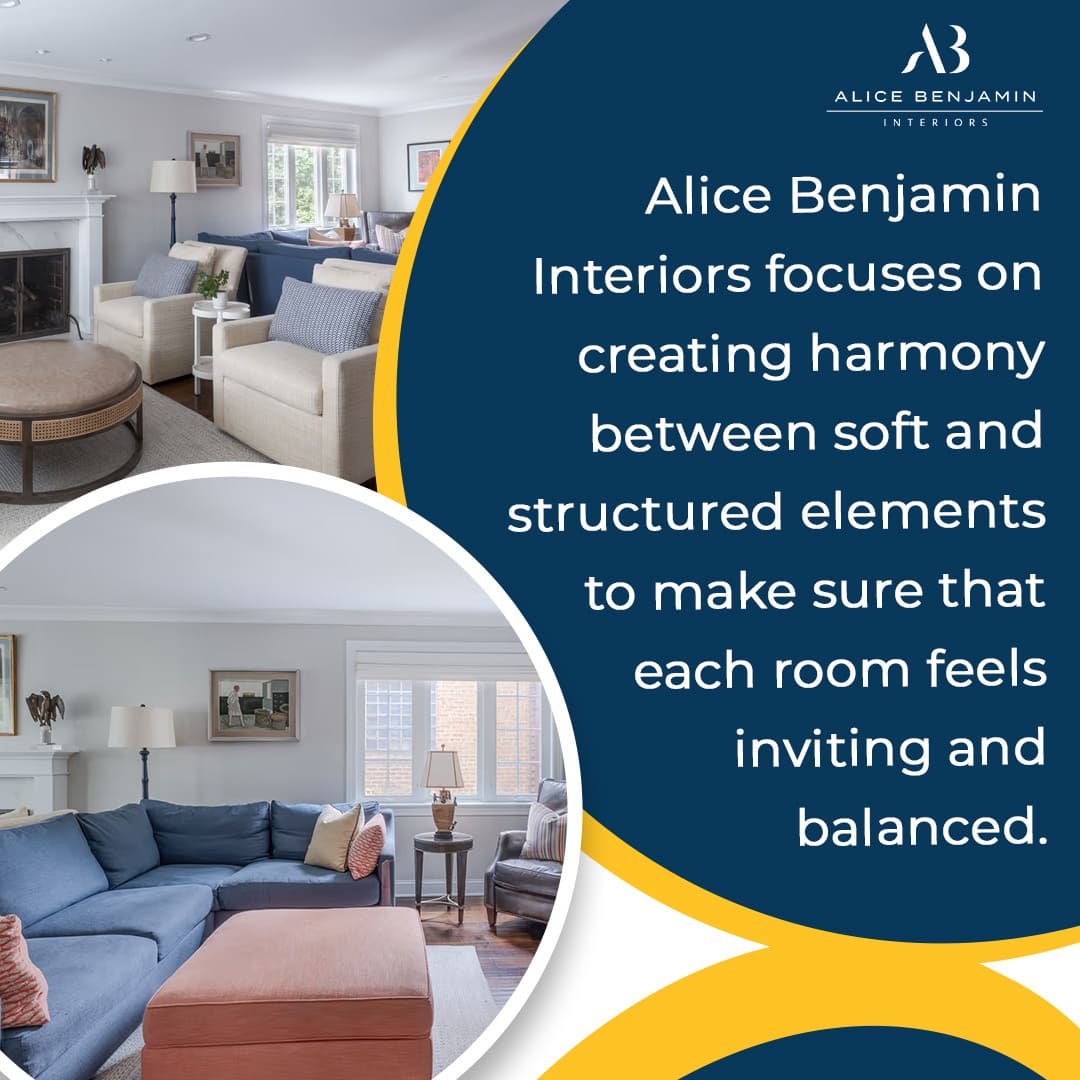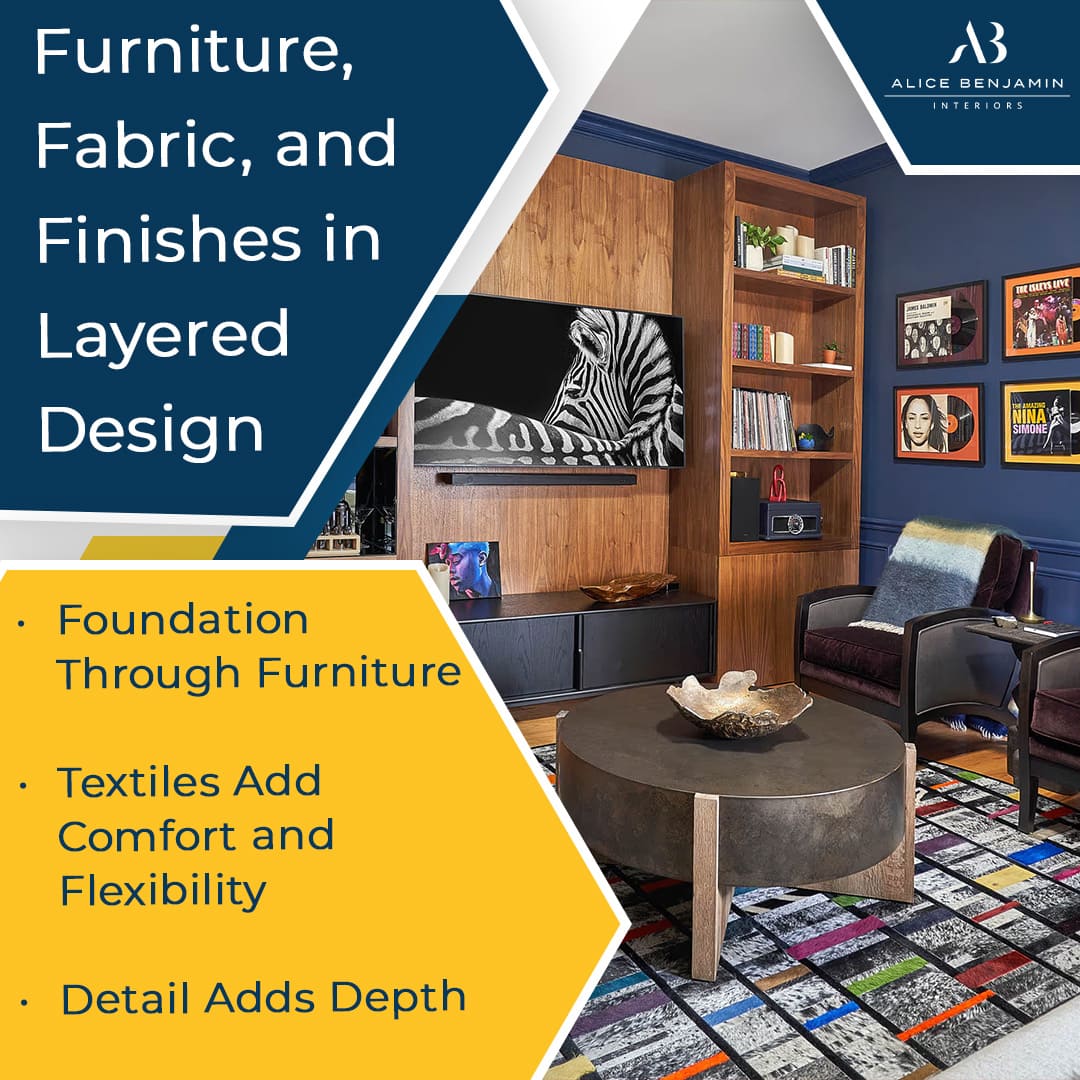Layering in interior design creates a sense of depth and tactile richness by carefully combining textures and materials. This approach transforms spaces into thoughtful, inviting environments that feel both refined and personal. At Alice Benjamin Interiors, I specialize in textural interior design that balances restraint with warmth, ensuring each element contributes purposefully to the whole.
When crafting sophisticated Chicago interiors, I consider how light, architecture, and lifestyle shape material choices. A layered home design reflects not only aesthetic harmony but also how you live within your space. Through intentional layering, I help you build interiors that evolve naturally over time, offering quiet elegance and comfort tailored to your unique story.
Layering in interior design goes beyond decoration; it shapes how you experience a space. By combining different textures and materials thoughtfully, you create interiors that feel alive, balanced, and tailored to everyday life.
Texture communicates emotion, movement, and energy within a space. It goes beyond color or shape to express the way a room feels to inhabit. When you touch or look at a surface, its texture speaks to you—it can soothe, energize, or provide a moment of quiet reflection.
Consider natural fibers like wool or linen. Their uneven surfaces and subtle variations bring warmth and softness that a flat-painted wall cannot replicate. For example, a lightly brushed oak cabinet carries a grounded, earthy quality that anchors a room. Meanwhile, a slubbed linen drape diffuses light gently, softening shadows and creating a calm atmosphere. Textured plaster walls add an almost sculptural element that invites closer inspection without overwhelming the senses. These textures contribute layers of sensory richness, inviting you to engage with your surroundings on multiple levels.
Layering introduces dimension by allowing each material to speak about the others. Rather than placing finishes and furnishings randomly, layering creates a conversation between surfaces that builds a sense of flow and progression through a room.
Imagine a wool rug resting beside a cast bronze table or a curved leather chair positioned near steel-framed windows. These elements contrast yet complement one another, creating a tactile and visual rhythm that draws you in. In layered home design, contrast is not simply decorative. It supports how a space functions, enhances mood, and echoes the architectural framework.
Layered interiors support how people live, not just how they look. Especially in a city like Chicago, where daylight shifts dramatically with the seasons, materials must respond to changes in light, temperature, and daily habits.
A boucle chair offers cozy comfort during cold winters, while a woven jute runner provides coolness and breathability in warmer months. These choices are about more than appearance—they reflect your lifestyle and the environment around you. Materials gain meaning through how they wear, how they feel, and how they perform over time.
At Alice Benjamin Interiors, I approach textural interior design as a balance of material and mood—blending texture, form, and utility. Each layer is chosen to reflect your rhythm and surroundings. In doing so, I help create interiors that are refined, timeless, and rooted in how you live within the character and pace of Chicago’s distinctive setting.

Materials and finishes form the foundation of any interior. In Chicago, where architecture and climate present distinct qualities, these choices matter deeply in shaping the character and comfort of your space.
Stone, wood, leather, and wool offer more than visual appeal—they establish a tangible relationship between your home and its surroundings. In a city like Chicago, where industrial materials and hard architectural lines are common, these natural textures bring balance. Their depth and irregularity add warmth that synthetic surfaces often lack, creating a softer, more grounded living experience.
In a brick-lined loft, polished plaster softens the backdrop, while hand-planed walnut cabinetry contributes warmth and craftsmanship. The combination of rough and smooth materials invites a layered sensory experience. In a more streamlined condo, quiet limestone paired with brushed linen brings clarity without austerity. These materials hold their character over time and support both comfort and longevity.
Structured pieces hold the room, while soft materials invite comfort. This dynamic balance brings life and rhythm to your interiors. Rigid forms offer stability and definition, while softer textures create inviting spaces that feel lived-in and approachable.
Consider an oak credenza with clean lines anchoring the dining room. Its solidity gives the room focus and form. Nearby, a wool-upholstered banquette introduces softness and intimacy, inviting people to linger comfortably. This interplay prevents any part of the space from feeling either too harsh or too fragile. Across a home, similar contrasts in materiality and scale work together, guiding movement and visual flow.
Satin finishes, natural patinas, and hand-applied treatments refine a space with restraint. Instead of high-gloss or overly reflective surfaces, I lean toward finishes that celebrate craftsmanship and authenticity.
Materials like tumbled marble, oxidized metals, milk paint, or unlacquered brass carry history in their textures and marks. These finishes develop character over time, enhancing rather than diminishing the layered design approach. This restraint avoids visual noise, allowing the inherent qualities of each material to shine. For instance, oxidized brass hardware deepens in tone over the years, creating a subtle but lasting impression.
At Alice Benjamin Interiors, I guide clients through selecting materials and finishes that resonate with their lifestyles and the architectural context of their Chicago homes. This approach helps create spaces that feel both timeless and deeply personal.
Creating a layered home design requires a thoughtful combination of materials and textures that work together to shape a cohesive environment. This section explores how furniture, textiles, and carefully chosen details come together to form interiors that feel both intentional and inviting.
Furniture sets the material tone of a room and gives structure to the design. I select pieces that provide both visual weight and quiet comfort—such as a wood table with expressive grain or seating that balances firmness and ease. Proportions matter; case goods should support a room’s flow, not interrupt it. Starting with a sculptural travertine coffee table or a natural wool bench gives the design clarity. These foundational elements create a starting point for layering, offering tactile and visual cues that guide the space without overcrowding or diluting its intent.
Textiles shape how a space feels by affecting light, acoustics, and emotional tone. The way fabric responds to daylight can shift the mood of a room as hours pass. A dense flatweave rug guides movement, while layered drapery softens edges and light. Throws, upholstery, and bedding adapt spaces to the seasons. In many Chicago homes, I often work with wool, linen, washed cotton, and silk blends. These materials aren’t chosen simply for appearance. Each one contributes to a composition that feels grounded, measured, and fully connected to the experience of daily living.
Details create cohesion between structure and style. Art and objects serve to tie together the design narrative. For example, a ceramic sculpture may echo the subtle matte texture of a plastered wall, while a custom sconce might reflect the clean lines of built-in millwork. In projects I work on, these elements are never afterthoughts or mere finishing touches. They are integrated into the same palette of restraint and material clarity as larger architectural features. This creates spaces where every detail feels deliberate and aligned, contributing to a harmonious whole.
At Alice Benjamin Interiors, I guide clients through a layered design process where furniture, textiles, and details come together seamlessly. Each element builds upon the last, resulting in interiors that feel purposeful, personal, and enduring.
Chicago’s unique urban landscape and climate shape how interiors come to life in the city. The architectural framework, seasonal shifts, and everyday living patterns all play a role in determining which materials and design approaches work best within a home.
Chicago homes ask for material clarity and warmth. The city’s iconic industrial elements, such as expansive steel-framed windows, exposed brick walls, and sturdy metal staircases, set a strong architectural tone. These features establish a raw, authentic backdrop that calls for thoughtful contrast. To balance the structural boldness, I bring in soft upholstery, hand-crafted millwork, and carefully applied plaster ceiling details. This combination respects the home’s original character while creating inviting and intimate environments.
Sophisticated Chicago interiors value substance over style categories. Rather than chasing fleeting trends, I prioritize honest materials and skilled craftsmanship that reflect how you live. These elements form the foundation for spaces that evolve gracefully rather than needing frequent updates. A home that embraces timeless design principles offers flexibility. It can adapt to new functions or tastes while retaining its core identity.
Chicago’s changing seasons shape choices in both palette and texture. Heavier fabrics like wool and velvet offer warmth in winter, while lighter linens and cottons refresh interiors in summer. This seasonal layering allows homes to adapt naturally. Sunlight also guides design: south-facing rooms with abundant light benefit from matte finishes to reduce glare, while north-facing spaces use warmer tones and reflective surfaces to enhance the softer, limited daylight they receive.
At Alice Benjamin Interiors, based in Chicago, Illinois, I integrate Chicago’s architectural heritage, seasonal climate, and everyday living patterns to craft interiors that feel authentic and enduring. The city’s influence guides choices toward materials and textures that speak clearly and thoughtfully, creating homes that reflect your life and environment in balance.

Collaborating on a layered home design grounded in textural interior design is a deliberate and thoughtful journey. At every step, the process is centered on your needs and how the design will enrich your daily life.
Each project begins with a conversation and listening. Before suggesting materials or textures, I want to understand how you live and what you value. This approach helps me create a space that feels authentic and aligned with your personality rather than applying a standard template. Through private and focused discussions, we explore your lifestyle, preferences, and practical needs. This measured process respects your rhythm and leads to a design that supports your everyday routines with ease. By engaging deeply at the outset, I can guide you toward materials and finishes that complement not only your aesthetic tastes but also your use of space.
Design develops across stages: discovery, design, sourcing, and installation. At every phase, material layering is intentional. Each phase builds on the previous one, starting with a careful evaluation of the space and your goals. This thoughtful progression allows for a natural evolution of ideas and selections. When choosing materials, I pay attention to how each piece interacts within the room and the larger home. Cohesion is essential, but so is the individual character that each element brings. This layered approach follows a clear timeline, keeping the project organized while allowing flexibility to respond to evolving preferences. It results in spaces that feel unified and carefully curated.
No texture or object is chosen arbitrarily. Every surface contributes to a home’s function, feeling, and memory. We consider wear, aging, tactility, and scale before selecting any material. This means materials are chosen not only for their appearance but also for their longevity and how they respond to daily life. Materials also hold memories and emotional resonance. Incorporating elements that reflect your background, travel, or family history adds layers of meaning to the home. This creates a space that is more than just a collection of objects; it becomes a living environment that tells your story.
If you are ready to transform your living space into one that reflects your unique story and lifestyle with thoughtful materials and refined design, I invite you to connect with me at Alice Benjamin Interiors. Together, we will create a home that balances elegance and personal meaning.
Contact me today at (872) 274-2724 or via email at admin@alicebenjamininteriors.com to schedule a consultation. Let’s explore how careful layering can elevate your home into a space that feels timeless and welcoming.
